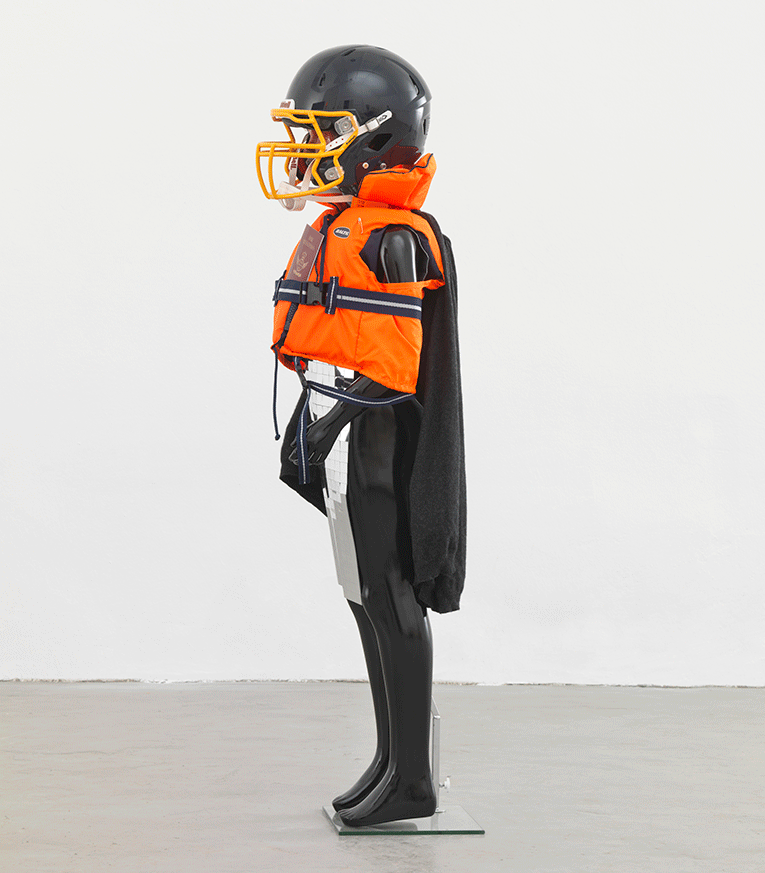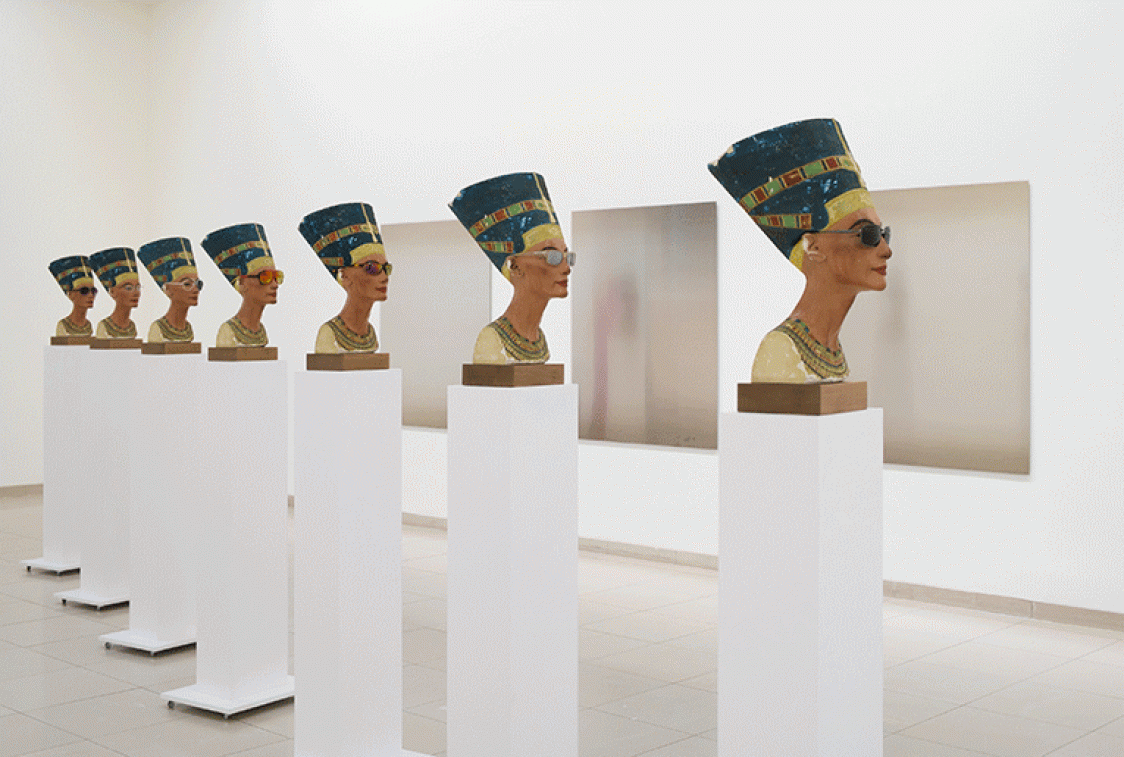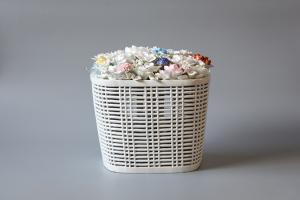ISA GENZKEN. NEW WORKS
MMK Museum für Moderne Kunst Frankfurt/Main
14 March — 31 May 2015
The sculptress Isa Genzken (b. 1948) is today one of the most influential women artists of her generation. The MMK Museum für Moderne Kunst in Frankfurt is presenting the artist’s most recent workgroup – “Actors” of 2014/15 – in Germany for the first time. “We are proud to be the first museum in Germany to show this new workgroup. The fact that Isa Genzken has already brought forth an entire new workgroup of such magnitude since her major retrospective at the Museum of Modern Art in New York in 2013 is amazing, and an expression of her tremendous creativity”, Dr. Susanne Gaensheimer, director of the MMK and curator of the exhibition, observed.
The exhibition consists of more than forty figures as well as several floor and wall works. In it Genzken once again demonstrates the consistency and radicalness with which she pursues her own sculptural work as well as the possibilities offered by the sculpture medium today. The “actors”, as the artists calls the figures, form the core of the show. They are sculptures made of typical shop-window mannequins that she dresses in her own worn-out clothing supplemented with work and protective ware and edged with decoration materials. With their limbs twisted, their bodies covered in places with reflective foil and different-coloured adhesive tape, and their faces and abstracted genitals spray-painted in garish hues, the figures have virtually been staged in the room in systemic constellations that also reveal autobiographical aspects. In the wall and floor works, Genzken collages pictorial fragments from the popular media with references to art of the past and personal photographs.
Since the 1970s, Genzken has developed an approach to sculpture that takes a critical look at the German and American art of the post-war years while at the same time bringing forth a wholly independent and distinctive pictorial language. The artist was already spending prolonged periods of time working in the United States during her student years.
There she made the acquaintance of pioneers of Minimal Art such as Lawrence Weiner, Dan Graham and Carl Andre and studied their approach to sculpture in depth. She was inspired by the artistic discourses of the time, but also by the futuristic architecture in the U.S. – the skyscrapers of glass and steel with their reflecting surfaces that, in terms of dimensions and modernity, represented a diametric opposite to the typical architecture of post-war Germany.

In the late 1970s Genzken executed her “Ellipsoids” and “Hyperbolos” workgroup, which proved decisive for the direction her art would take. Three to nine metres in length and the products of elaborate working processes, these stereometric wooden sculptures are an expression of Genzken’s radical self-positioning and an endeavour to employ the medium of classical sculpture to bring about an experience of space that breaks with all conventions.
Owing to their shapes and dimensions, it is impossible for the viewer to grasp them in their entirety from a single vantage point. Only by moving around them and contemplating them from different perspectives can he come to an understanding of their overall abstract forms. This workgroup was the point of departure for Genzken’s defiant exploration of the sculpture medium and its spatial experience by the beholder, an issue she has continued to pursue to this day.
In the late 1980s, under the influence of the emerging Techno scene, the gay movement and the global consumer culture boom, Genzken’s pictorial language underwent a fundamental change. She began to develop her own collage technique, combining snippets of pop culture images with illustrations of motifs from the art of the past and biographical photographs on large-scale aluminium panels. To these elements she added mirror foil mosaic and accentuated the surfaces with spray paint in different colours. The Briefmarken (Stamps) of 2014 on view in the MMK show are a continuation of that early workgroup.
In the 2000s, Genzken’s collages gradually evolved into small-scale three-dimensional assemblages presented at eye level on white bases. They consist of stage-like scenarios assembled from dolls, toy figures, housewares and decoration objects from discount shops. With their garish and psychedelic aesthetic and their quality of three-dimensional storyboards, these sculptural works consistently make allusion to current topics and testify to the artist’s ongoing concern with the present.
Often her own biography and a kind of weighing and balancing process between the self and the vis-à-vis play a key role. The series “Empire/Vampire. Who Kills Death” (2002–04), for example, came about under the influence of her personal experiences in New York at the time of the September 11, 2001 attacks on the World Trade Center. The assemblages in this workgroup depicted destroyed urban landscapes reminiscent of war films or apocalyptic scenarios. In later years these model-like works developed into installations that transform the exhibition space into stage-like settings.
Concurrently with her work in the sculpture medium, Genzken has also been working with film for many years. She considers film the most democratic medium of the visual arts. “I always wanted to have the courage to do something completely different, completely crazy and impossible, or even wrong. … For me film is the combination of all the arts, and possibly the most public art, that is, the one most seen. That’s what makes it so appealing to develop truly new ideas for film”, Genzken once remarked.
The artist is interested in the specific reception conditions that distinguish film, and she applies them to her sculptural practice. Whereas in a film the viewer is led through a setting by the camera, Genzken designs her stage-like sculptural installations in such a way that the exhibition visitors can appropriate the works’ contents on their own. “I want to make sculptures that represent a scene in a film, in other words have model character, not sculpture in the traditional sense”, says Genzken.
Within the framework of the exhibition at the MMK 1, three films dating from different phases of the artist’s career are also being featured. The early work “Zwei Frauen im Gefecht (Two Women Engaged in Combat)” of 1974 is being presented as part of the exhibition. Produced during the artists’ student years in Düsseldorf, the film shows Genzken and her fellow student Susan Grayson exchanging their entire apparel several times. “Die kleine Bushaltestelle (Gerüstbau) (The Little Bus Stop [Scaffolding])” of 2012 and “Meine Großeltern im Bayrischen Wald (My Grandparents in the Bavarian Forest)” of 1992 will be screened as part of the programme accompanying the show. All three films are devoted to Genzken’s investigations of role models as well as the question of her own personal and artistic position.
Conceived in close collaboration with the artist, the exhibition is being co-produced with the Museum der Moderne in Salzburg.
Opening: Friday, 13 March, 8 pm
Accompanying Program:
Lecture: Benjamin H. D. Buchloh: The Ready-Made Figure Sculpture
Wednesday, 18 March 2015, 7 pm at the MMK 1
One week after the opening, the internationally noted art historian Benjamin H. D. Buchloh will give a lecture discussing Isa Genzken’s most recent workgroup.
Over the past thirty years, Buchloh has published a large number of texts on Genzken’s œuvre. In addition to being friends, Genzken and Buchloh have been engaging in intense professional discourse since the beginnings of her artistic career. In his lecture at the MMK 1, Buchloh will concentrate on the artist’s most recent workgroup, the so-called Actors, placing the works in a historical context ranging from Dada to French Surrealism.
Benjamin H. D. Buchloh is a professor of modern art at Harvard University and co-editor of the American art journal October. In 2007 he was the first art historian to be awarded the Golden Lion at the Biennale in Venice for his outstanding contribution to contemporary art.
Admission free; the lecture will be held in English and streamed live on the MMK website www.mmk-frankfurt.de
Film screenings:
Meine Großeltern im Bayerischen Wald (My Grandparents in the Bavarian Forest; 1992)
Wednesday, 22 April, 7 pm
Isa Genzken shot the film about her grandparents shortly before their death. It tells about the everyday lives and routines of the solitary couple and provides insights into their private realm without revealing it to the public. The grandparents’ house and world form a veritable counter-world to the sculptures by Genzken on view in the exhibition.
Die kleine Bushaltestelle (The Little Bus Stop; 2012)
Wednesday, 13 May 2015, 7 pm
The film shows a series of brief episodes in which Isa Genzken and her longstanding artist friend Kai Althoff talk about various topics – in part existential, in part trivial and commonplace – in the roles of two prostitutes, hotel guest and waiter, artist and fan, commissioner and policeman. In crude, tragicomic dialogues they polemicize with blunt sarcasm about firmly established role models, social codes and personal neuroses, but also the unreliability of the German weather forecast.
MMK 1
Domstraße 10
60311 Frankfurt am Main
Telephone +49 69 212 30447
Fax +49 69 212 37882
http://www.museumdermoderne.at/
E-Mail: mmk(at)stadt-frankfurt.de
Image Credits:
1. Isa Genzken, Nofretete, 2014; Courtesy Galerie Buchholz, Berlin/Köln, Hauser & Wirth, Zürich/London, David Zwirner, New York, Installationsansicht/exhibition view: Isa Genzken. New Works, MMK Museum für Moderne Kunst, 2015 Foto/photo: Axel Schneider © VG-Bild Kunst, Bonn 2015
2. (2) Isa Genzken, Untitled, 2014; Courtesy Galerie Buchholz, Berlin/Köln © VG-Bild Kunst, Bonn 2015



